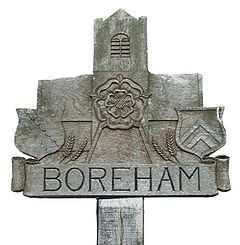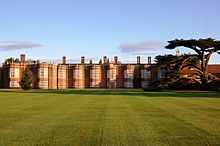Boreham
| Boreham | |
 Village sign |
|
 Boreham | |
| Area | 6 sq mi (16 km2) |
|---|---|
| Population | 4,000 |
| - Density | 667 /sq mi (258 /km2) |
| OS grid reference | TL759099 |
| Civil parish | Boreham |
| District | Chelmsford |
| Shire county | Essex |
| Region | East |
| Country | England |
| Sovereign state | United Kingdom |
| Post town | CHELMSFORD |
| Postcode district | CM3 |
| Dialling code | 01245 |
| Police | Essex |
| Fire | Essex |
| Ambulance | East of England |
| EU Parliament | East of England |
| UK Parliament | Saffron Walden |
Boreham is a village and civil parish, in Essex, England. It is located approximately 6 km (3.7 mi) northeast from the county town of Chelmsford. The village is in the borough of Chelmsford and parliamentary constituency of Saffron Walden.
History
The parish of Boreham is ancient, and the village is mentioned in the Domesday Book as Borham.[1]
Local legend holds that highwayman Dick Turpin rode the A12 on his famous ride from London to York, although historians now believe the ride never occurred.
.jpg)
In 1952 a Ham class minesweeper, HMS Boreham, was named after the village.
Boreham remained relatively small until the mid-1970s when a programme of house and shop building increased its size significantly.
Geography and administration
In addition to being a village, Boreham is a civil parish which has a parish council[3]
The village lies on a Roman road (now a modern trunk road, the A12) and has a well known Norman church and a public house (The Cock Inn) that dates from the 15th century. The surrounding countryside is gently hilly and is used to grow crops such as wheat, sugar beet and peas. It is north of the River Chelmer.
The Great Eastern Main Line line from Chelmsford to Colchester runs past the village, but the Boreham's local halt was removed in the 1960s as part of the Beeching cuts. In the 1970s a bypass was built on the edge of the village, along the same route as the A12 and the nearby railway line.
Boreham has a population of approximately 4000 people. It covers about 1554 hectares of land.[4]
Landmarks
New Hall School

Just outside the village is New Hall School, once a palace of Henry VIII known as The Palace of Beaulieu. The estate on which it was built - the manor of Walhfare in Boreham - was granted to the Canons of Waltham Abbey in 1062.Charter S 1036 After various changes of possession it was granted by the Crown to the Earl of Ormond in 1491. By this time it had a house called New Hall.
In 1517 New Hall was sold by Thomas Boleyn to Henry VIII of England. The king rebuilt the house in brick at a cost of £17,000, a considerable sum at the time. He gave his new palace the name Beaulieu, though the name change did not outlast the century. New Hall was later the estate of the Tyrell family and latterly the Hoare banking family. Benjamin Hoare commissioned architect Henry Flitcroft to build a new home nearby known as Boreham House, a stately home in 1727; the early Georgian mansion is now a Grade I listed building.
Boreham airfield

A forest near the village was felled in 1943 to build a military airfield, and the three one-mile (1600 m) runways of RAF Boreham opened in 1944. It hosted elements of the US Army Air Forces 394th Medium Bomb Group (flying B-26 Marauder bombers)[5] and later the 315th Troop Carrier Group flying C-47s. After World War II the three runways were adapted into a roughly triangular motor racing circuit Boreham Circuit, which hosted competitive meetings between 1949 and 1952. It was bought by Ford in 1955 for use as a development test track.[5] Ford Motorsport moved to Boreham in 1963, and although some of the track was removed for gravel quarrying in 1996 the remaining track surface continues to be used for testing. Essex Police Air Support Unit have been based at the airfield and in 1990 began using Boreham airfield as a control centre for its fleet of helicopters.[5] From 1997 to 2010, Essex Air Ambulance was also based at the site.[5]
Boreham Interchange
To the west of Boreham lies the Boreham Interchange. The Boreham Interchange plays host to a service station containing:
- a McDonald's with a drive through;
- a BP Petrol Station;
- a Premier Inn.
On the opposite side of the A12 there is another Premier Inn and The Grange, a pub.[6]
Notable residents
- Elizabeth Stafford, Countess of Sussex - is buried in the village.
- Thomas Wharton, 2nd Baron Wharton - was given a residence in the village by Queen Mary I of England.
- Rod Harrington - Former darts player.
References
- ↑ "Image details (Boreham, Essex)". www.nationalarchives.gov.uk. Retrieved 2007-01-29.
- ↑ "Silsoe College timeline". Retrieved 2008-04-10.
- ↑ "Parish Councils". www.chelmsford.gov.uk. Retrieved 2007-01-28.
- ↑ http://www.essexinfo.net/borehamparishcouncil/
- ↑ 5.0 5.1 5.2 5.3 "Air Support Unit Location". www.essex.police.uk. Archived from the original on 2006-11-30. Retrieved 2007-01-29.
- ↑ http://www.chefandbrewer.com/Grange/pid-S3928
External links
| Wikimedia Commons has media related to Boreham. |
- Boreham Parish Council
- A 1912 postcard photo of Boreham House
- Details of the Boreham airfield and test-track
| ||||||||||||||||||